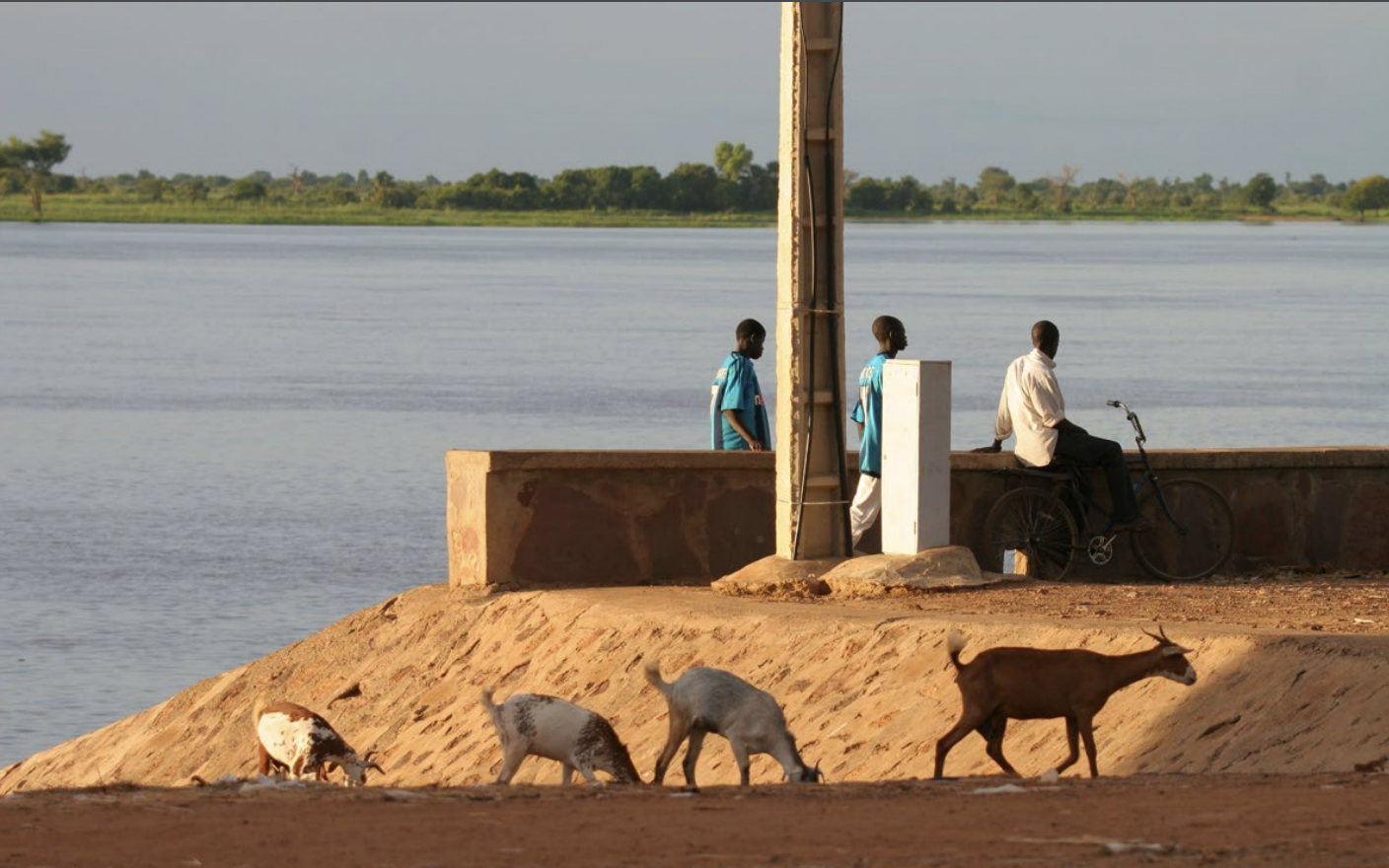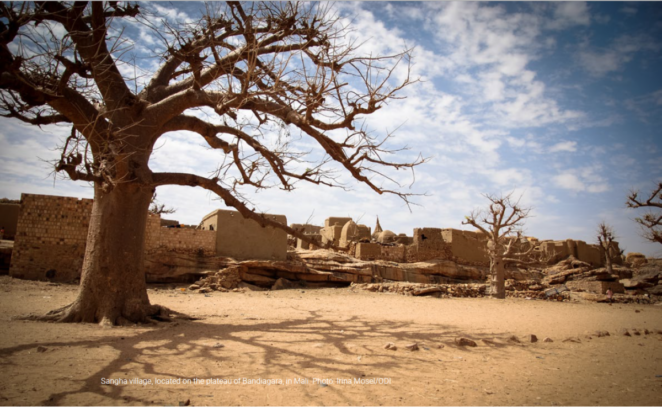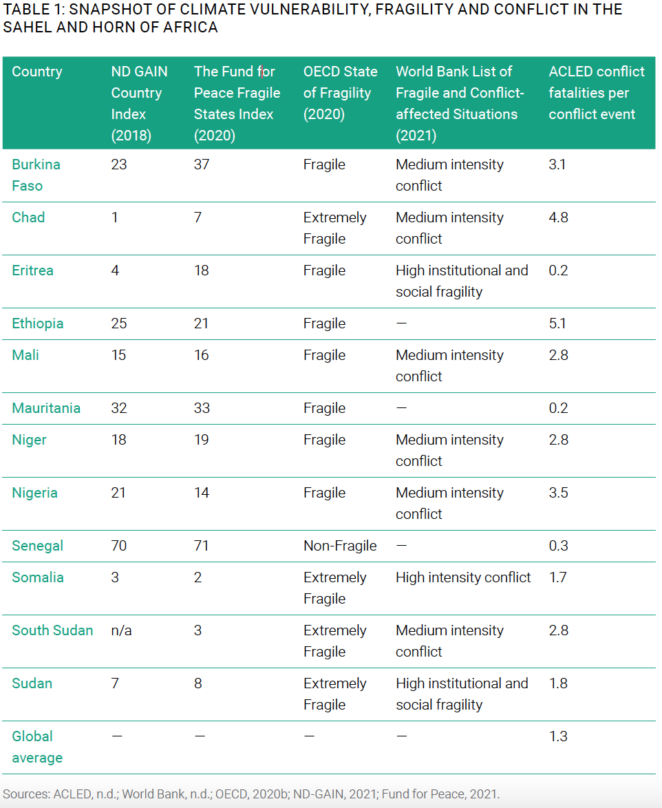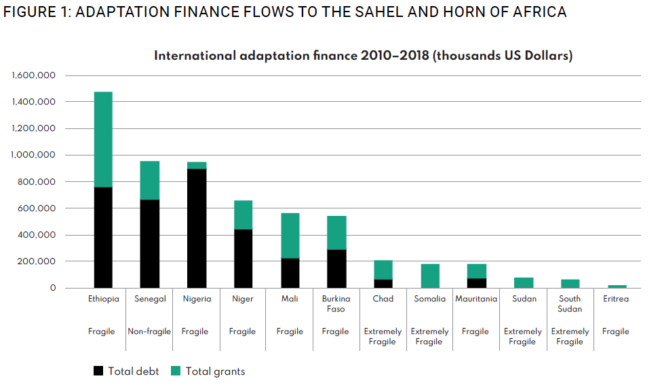Synthesis report: Exploring the conflict blind spots in climate adaptation finance

Introduction
In many fragile and conflict-affected situations, climate change and conflict tend to interact with each other, compounding risks and challenges for sustainable development. While not directly causing conflict, climate impacts can exacerbate issues that drive conflict, such as degradation of natural capital and livelihood assets, infrastructure damage, food insecurity and migration. Conflict, in turn, can amplify the impacts of climate change by increasing communities’ and institutions’ exposure and vulnerability to climate-related hazards and lowering their capacity to adapt.
Despite this relationship, there is limited evidence to date that climate adaptation programmes are being implemented in a conflict-sensitive manner. In addition, multilateral climate funds and some bilateral donors tend not to allocate funds in fragile and conflict-affected situations, seemingly due to perceived higher risks and challenges. This results in what amounts to ‘blind spots’ that both increase the risk of ill-designed adaptation programmes precipitating grievances and conflict situations, causing unintended harm, and prevent adaptation finance from reaching those arguably most in need of support.
This synthesis report explores: (1) How can the design and delivery of climate adaptation programmes be improved so that they help reduce risk related to both climate and conflict?; and (2) How can climate adaptation finance be increased to fragile and conflict-affected situations?.
It is based on an analysis of donors’ approaches to conflict sensitivity in the Sahel and Horn of Africa – a region with a large concentration of highly climate-vulnerable and conflict-affected countries – and synthesis of findings from the application of such approaches to climate adaptation investments in Mali, Somalia and Sudan.
*Download the full report from the right hand column. The key messages from the report are provided below. See the full text for more detail
Methodology
This report uses conflict sensitivity as a framework to analyse the findings from the research into donors and the country case studies.
A mixed-method approach was used for data collection, consisting of: (1) a brief literature review of the climate–conflict nexus and established conflict-sensitive programming approaches; (2) descriptive analyses of climate adaptation finance flows at regional and country levels; and (3) in-depth qualitative assessment of conflict sensitivity in climate adaptation programme design documentation and via interviews with 41 key informants.
Conflict sensitivity is generally comprised of three essential components:
- comprehensive understanding of the operational context
- holistic understanding of the two-way interaction between interventions and the conflict context (i.e. the intervention’s influence on conflict, and how the conflict contexts affect the intervention)
- commitment both to avoid reinforcing conflict dynamics and to maximise opportunities for positive impacts.
While the purpose of a conflict-sensitive analysis is to reduce negative impacts on conflict, the analysis may reveal that there is no ‘right’ solution for the intervention to be accepted by all interest groups, as it may contribute to redistribution of power or resources or may affect the interests of those most powerful. This raises questions of how to address trade-offs and dilemmas. In such situations, the process through which interventions are made conflict sensitive and delivered is key. Hence, conflict-sensitive interventions should be guided by principles of responsibility, participation, transparency, inclusiveness, respect, accountability, timeliness and partnership in how they deal with:
- selection of communities
- procurement and provisioning of resources
- establishment of feedback and accountability mechanisms
- building relationships with targeted communities, governments, donors and development partners
- the intervention’s exit strategy.

Lessons Learnt
This section synthesises key findings, common themes, and knowledge gaps from across the donor analysis and country case studies. The insights are clustered into the ‘three essential components’ of conflict sensitivity, illustrating whether and how adaptation programmes have been conflict-sensitive, and around the barriers to accessing adaptation finance in FCSs (fragile and conflict-affected situations).

Limited information on conflict analyses informing adaptation
There was limited information on the depth, scale and regularity of conflict analyses informing planning and design of adaptation interventions. A comprehensive understanding and analysis of the conflict context is a key component of effective conflict sensitivity in programmes. However, project proposals analysed across the three countries did not provide consistent evidence that conflict analyses had been undertaken to inform project design.
- Programme proposals varied in the evidence and degree of conflict analysis used to inform proposal design and inform implementation over programme duration.
- There is a lack of donor strategies and policies linking climate change to conflict and fragility.
Risk analyses tend to neglect the two-way interaction between interventions and the conflict context
Conflict sensitivity involves a holistic understanding of the two-way interaction between intervention and the conflict context. However, the review of adaptation documentation in this study reveals that the most consistent focus was given to operational hazards – how an escalation in conflict might affect an intervention – with less attention to the potential impact of the intervention on conflict (‘do no harm’). This may be caused by local adaptation planning not having a central role to reflect local priorities, including on conflict dynamics.
- Most projects have focused on being ‘security aware’, rather than on potential impacts on conflict dynamics.
- Projects that acknowledged potential impacts to the conflict context focused on communal tensions, generally over land and water resources and typified by farmer– herder conflicts.
- A lack of conflict sensitivity may be explained by challenges of adaptation money flowing to the local level and empowering local planning.
Investment often avoids armed conflict areas, leaving behind vulnerable people
In all three case study contexts, where insecurity and conflict levels were deemed too high, donors’ commitment to avoid reinforcing conflict dynamics often manifested as active decisions not to invest in areas under militia control, leaving behind populations in these vulnerable areas (Figure 1).
- Donors’ decisions about where to operate seems to be influenced by their risk perception and processes to manage risks.
- Donors may need more expertise or to provide more incentives to cultivate support for the conflict and climate nexus.
- Donor coordination is further needed to improve the geographic and programmatic range of conflict-sensitive climate projects.

Adaptation programmes miss opportunities to support conflict prevention
Adaptation programmes have not consistently provided evidence of an intention to maximise opportunities for positive impacts on conflict prevention or resolution, despite these opportunities existing. A lack of access to complete adaptation project documentation, monitoring and evaluation reports, and post-programme impact assessments meant that it was not possible to determine the impact of climate finance on multi-dimensional levels of conflict.
- There is substantial opportunity and increased appetite to use adaptation financing in programmes working on communal conflict.
Conflict worsens the problems of accessing climate finance
While not unique to FCSs, the persistent challenges in accessing adaptation finance are exacerbated by instability associated with conflict conditions. Donors need to consider three main issues to improve access to adaptation financing in FCSs: (1) Weak government capacity and governance, arising from or contributing to conflict, is central to understanding current climate-finance access and delivery modalities in conflict-affected contexts; (2) Donors’ demanding bureaucratic requirements, especially concerning fiscal risks, result in the control of concept note and proposal development being ceded to international institutions; and (3) the minimum data required for proposals is often simply lacking in certain conflict-affected zones.
- The different levels of government understanding and knowledge of climate change challenges determine their engagement with international climate finance.
- Weak government capacity to meet fiduciary standards.
- High staff turnover, and loss of skilled personnel and institutional memory, contribute significantly to governments’ low institutional capacity.
- Donor access requirements for climate finance are complex and rigid for national institutions and do not seem to account for rapidly changing conflict contexts.
- The minimum data required for proposals is lacking in certain conflict-affected zones.
Conclusions
Given the interrelationship between climate change and conflict in fragile and conflict-affected situations (FCSs), climate adaptation finance allocation to such countries needs to be conflict sensitive. Building upon the key insights in the previous section, the report provides answers to the two overarching research questions:
How can the design and delivery of climate adaptation programmes be improved so that they help reduce risk related to both climate and conflict?
- Articulate the climate adaptation and conflict nexus across donor, government and implementing-agency strategies, action plans, policies and guidance materials for investments.
- Improve guidance and capacities for conflict sensitivity analysis and support project portfolio reviews with a conflict lens to generate learnings to improve practice.
- Ensure that local leaders and all key local stakeholders are actively participating in investment design and implementation via inclusive approaches that recognise the heterogeneity of communities.
- Create more flexible operational protocols during implementation of adaptation investments.
How can climate adaptation finance be increased to fragile and conflict-affected situations?
- Improve coordination among donors, based on risk preferences.
- Revise donor modalities to provide capacity-building support for climate change adaptation.
- Support improved public financial management (PFM) systems.
- Actively explore how access requirements of multilateral climate funds, such as the GCF, could be adapted to FCSs.
Suggested Citation
Cao Y., Alcayna T., Quevedo A. & Jarvie J. (2021) Exploring the conflict blind spots in climate adaptation finance. SPARC.
Related resources
- Climate and Syria: did the media get it right?
- The NAP Process and Peacebuilding
- Insurgency, Terrorism and Organized Crime in a Warming Climate
- Accessing and Using Climate Data and Information in Fragile, Data-Poor States
- Financing from the Ground Up - Experiences in Adaptation Finance from Southeast Asia
(0) Comments
There is no content